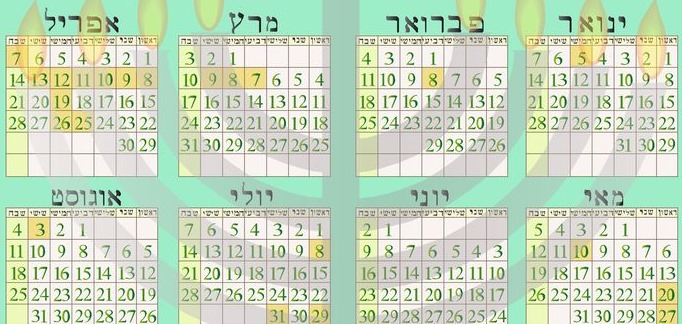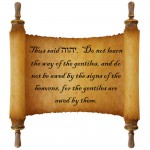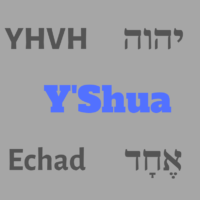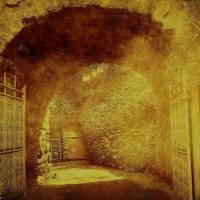Introduction
In our previous article, we explained why we follow the Sighted Moon Calendar. We also explained, why we believe that it is scriptural to start the new year according the Aviv barley. Judaism does not follow this calendar anymore. Today, Judaism follows the Hillel II calendar. How did it come about that they changed? How do they differ from the Sighted Moon / Aviv Calendar? We will investigate these topics and then explain why we do not follow this calendar. Once again, we are not starting a debate here. We are explaining our point of view.
The History of the Jewish Calendar
Most people believe that Hillel II, also known as Hillel the Younger, introduced the calculated calendar. Hillel II introduced his calendar around 359 C.E. But the change in the calendar started much earlier. The sages of Judaism introduced these changes over time and later we arrived at what Hillel II published as his calendar. Let us see how these changes progressed.
In this study, we will need to use a lot of historical records. Works like the Mishnah and the Talmud record the history of Judaism. The fact that we reference these works does not mean that we see them as binding instructions. We treat these documents as pure historical documents. This would put them in the same category as works like Josephus, Philo or Plinny the Elder.
Start of the year
As we know from the previous article, the calendar described in the Scriptures is a lunar/solar calendar. The cycle of the moon determines the start of the month and the cycle of the sun indicates the start of the year. The ripening of the barley in Jerusalem is the indicator of when the new year must start.
In order to determine the condition of the barley, the priests had to have access to Jerusalem. When Israel was deported to Babylon, they no longer had access to the barley in Jerusalem. This meant they had to find a new way to determine the new year. It is most likely that the addition of three additional new years started during the exile. In the Mishnah, we find the following:
A There are four new years:
B (1) the first day of Nisan is the new year for kings and festivals;
C (2) the first day of Elul is the new year for tithing cattle.
D R. Eleazar and R. Simeon say, “It is on the first day of Tishre.â€
E (3) The first day of Tishre is the new year for the reckoning of years, for Sabbatical years, and for Jubilees,
F for planting [trees] and for vegetables;
G (4) the first day of Shebat is the new year for trees, in accord with the opinion of the House of Shammai.
H The House of Hillel say, “On the fifteenth day of that month [is the new year for trees].†1
Hillel the Elder and Shammai were two leading rabbis in the first century before Y’Shua. In this verse, we see that the disciples of Hillel the Elder had already started to add additional new years to the calendar. Thus, we know from this text that after the first century before Y’Shua, the sages had already introduced additional new year’s days into the calendar.
However, according to Philo the month of Aviv was still the beginning of the Scriptural new year. Â Philo, who was a Jewish philosopher that lived from 20 B.C. to 50 C.E. Â describes the months as follows:
XXVIII. (150) And there is another festival combined with the feast of the passover, having a use of food different from the usual one, and not customary; the use, namely, of unleavened bread, from which it derives its name. And there are two accounts given of this festival, the one peculiar to the nation, on account of the migration already described; the other a common one, in accordance with conformity to nature and with the harmony of the whole world. And we must consider how accurate the hypothesis is.
This month, being the seventh both in number and order, according to the revolutions of the sun, is the first in power; (151) on which account it is also called the first in the sacred scriptures. And the reason, as I imagine, is as follows. The vernal equinox is an imitation and representation of that beginning in accordance with which this world was created. Accordingly, every year, God reminds men of the creation of the world, and with this view puts forward the spring, in which season all plants flourish and bloom; (152) for which reason this is very correctly set down in the law as the first month, since, in a manner, it may be said to be an impression of the first beginning of all, being stamped by it as by an archetypal seal. 6
In his discussion on Pesach and the month of Aviv, he mentions that Aviv is the first month according to Scripture and law. Philo also mentions that  Aviv is the seventh month according to the solar orbit. Thus, for the solar cycle he saw Tishri as the start of the year, but according to the law, he reckoned Aviv as the start.
The period from 10 C.E. to 210 C.E. is known as the era of Tannaim (repeaters or teachers.) This is the period in time when most of the rabbis mentioned in the Talmud lived. We see quite often in the Mishna that Tannaite authority is the basis of their teachings. This simply means that they base their ruling on the teachings of the rabbis in this period. The rabbis changed the start of the new year during this period. We see in the Babylonian Talmud that extra conditions are now added to the Aviv barley.
b. Sanh. 1:1, VIII.7.A–8.F
Our rabbis have taught on Tannaite authority:
B. On account of three signs do they intercalate the year, because of the [premature state of] the grain, because of the condition of the produce of the tree[s], and because of the lateness of the spring equinox.
C. On account of any two of these they will intercalate the year, but on account of only one of them, they will not intercalate the year.
D. [T. adds: But if they declared the year to be intercalated, lo, this is deemed intercalated.]
E. If the premature state of the grain was one of them, they would rejoice.
F. R. Simeon b. Gamaliel says, “Also on account of the lateness of the spring equinox†[T. San. 2:2].
G. The question was raised: Did he mean, “On account of the lateness of the equinox they rejoiced, or on account of the lateness of the equinox they intercalated the year�
H. The question stands.
VIII.8 A. Our rabbis have taught on Tannaite authority:
B. On account of [evidence of conditions in] three regions [viewed as distinct districts] do they intercalate the year: Judea, TransJordan, and Galilee.
C. On account of evidence produced in two of them they intercalate the year, but on account of evidence deriving from only one of them they do not intercalate the year.
D. [T. adds:] But if they declared the year to be intercalated, lo, this is deemed intercalated.]
E. And if the land of Judea was one of the two regions, they would rejoice,
F. because of the first fruits of grain which come only from Judah [for the altar]. [T. San. 2:3].2
From this recording we see that they base the change on the rabbinical authority, not the Scripture. They introduced the spring equinox and the condition of the produce of the trees as factors for the start of the new year. They based this on their interpretation of the Song of Solomon.
Song of Solomon 2:10–13
10 “My beloved responded and said to me, ‘Arise, my darling, my beautiful one, And come along. 11 ‘For behold, the winter is past, The rain is over and gone. 12 ‘The flowers have already appeared in the land; The time has arrived for pruning the vines, And the voice of the turtledove has been heard in our land. 13 ‘The fig tree has ripened its figs, And the vines in blossom have given forth their fragrance. Arise, my darling, my beautiful one, And come along!’ â€
What is interesting is that it requires only two of the three conditions for them to delay the start of the year. If the barley is Aviv but the fruit are not yet in the correct state and it is before the equinox, the new year may not start. It is also specific that this is measured in Judea, Transjordan and Galilee. Judea must always be one of the three where the conditions are favorable. Judea is where the temple is. After the Bar Kochba revolt in 132 – 135 C.E. the Jews were banned from Jerusalem. Thus, they could no longer determine the condition of the barley in Jerusalem. They could still use other parts of Judea. This practice is nowhere recorded in scripture and they do not claim that it is scriptural. The introduction of the equinox for determining the new year is thus a tradition of men.
It is uncertain when exactly this tradition started. The first council of Nicea (325 C.E) separated the dates of Pesach and Easter. They included the equinox into the calculation for the date of Easter. The reason for changing the date was that they did not want to rely on the Jews to tell them when to celebrate their feasts. If Judaism had already introduced the equinox, the council would not have introduced this.
From the Mishnah and the Talmud we see that the start of the new year was already modified and changed long before the time of Hillel II. Let us now look at the change to the start of the month.
Start of the month
We know from the historical records that Judaism still used the sighting of the new moon during the Second Temple period. We also have proof that this practice continued even after the Romans destroyed the second temple. A group of Jewish scholars, Rabbi Yochanan ben Zakkai and his disciples, fled from Jerusalem before the destruction. They settled themselves in a town called Yavneh (Yavne, Yabneh or Jamnia). Rabbi Yochanan established a Sanhedrin there that could instruct the scattered communities. This instruction included the setting of the date for new months. Rabbi Yochanan was the leader of the council from around 70 to 80 C.E. He was succeeded by Gamliel II.3
We know from the recordings in the Mishnah, that Rabbi Yochanan still used the sighting of the moon to determine the start of the month. His rulings made some changes to the halacha to allow for the destruction of the temple. Here is one such an example that illustrates this point.
Rosh Hashanah 4:4
E When the Temple was destroyed, Rabban Yohanan b. Zakkai made the rule that they should [once more] receive testimony about the new moon all day long.
F Said R. Joshua b. Qorha, “This rule too did Rabban Yohanan b. Zakkai make:
G “Even if the head of the court is located somewhere else, the witnesses should come only to the location of the council [to give testimony, and not to the location of the head of the court].â€1
We see from this passage in the Mishnah that they still received the witnesses to the new moon in Yahneh.
Originally, they used beacon fires to signal the start of the new month. Due to the fact that the Samaritans lit fires on wrong days to confuse them, they started sending our messengers. This was done in the time of Rabbi Judah I. He lived from 135 to 220 C.E and was the first of Hillel’s successors to be called “Nasi.” In the Jerusalem Talmud he is most often referred to simply as “Rabbi.” In this passage from the Jerusalem Talmud we see that he had stopped the beacon fires. 4 
[C] Who discontinued the beacon fires?
[D] Rabbi discontinued the beacon fires, and he permitted the murderer [to testify concerning the new moon], and he permitted hearsay testimony in the same matter, and he permitted them to go out on at twilight at the end of the twenty-ninth day of the lunar month or the night that marks the commencement of the thirtieth day while it was still evening, in the assumption that the new month would be sanctified the next day.
[E] R. Abbahu said, “Even though you say that they discontinued the beacon fires, they did not discontinue those from the Sea of Tiberias.â€
[F] R. Zeira asked before R. Abbahu, “Regarding those that we see at Safed. why do they light beacons?â€
[G] He said to him, “Rabbi discontinued the beacon fires. So with regard to Safed, why does it light beacons?â€
[H] “It is only for the sake of declaring the matter, to make sure that they. know.â€
[I] They do not raise up [beacons to signal] the night of its proper time [the thirtieth day of the lunar month], but rather [to signal] the night of its intercalation.
[J] They do not raise up [beacons to signal] the night of its proper time because of the Festival day, but they raise them up the night of its intercalation.
[K] They do not raise up [beacons] except for the new moons which are established in their proper time, because of the Festival that happens to fall on the Eve of the Sabbath. [Goldman: in this way no confusion would develop when the fire was seen on the Saturday night following a New Year that began on Thursday night. Potentially, the same confusion might otherwise also develop in any case where a defective month would end on Thursday evening. In such cases the beacons were lit on the night that began the thirty-second day.]
[L] They do not raise up [beacons] the night of its proper time because of festival day. They do not raise up [beacons] the night of its intercalation because of honoring the Sabbath.
[M] Now if you say to raise them up whether for the New Moons which are established in their proper time, or whether for intercalated months which are not established in their proper time, if you say thus, they would think perhaps the Court had ruled to intercalate and they become disordered. 5
This required that messengers had to be sent to all the communities. So what happens if the new moon is sighted on a sabbath? Are the messengers allowed to go out?
m. Rosh Hashanah 1:4
A On the occasion of two new moons [witnesses to the new moon] violate [the prohibitions of] the Sabbath:
B at Nisan and at Tishre.
C For on these occasions the messengers go forth to Syria.1
We know that it would not be possible for messengers to travel fast enough to get the message to all Jewish communities in the diaspora. This lead to the fact that the the Jews in the diaspora had to celebrate feasts for two days. This is most likely the reason why the calculated calendar became more popular.
One of the main proponents of the calculated calendar was Mar Samuel. He was also known as Samuel Yarhina’ah. He was born around 165 C.E. in Nehardea, Babylon. He was a scholar in the Law, medicine and astronomy. He was the son of a silk merchant. He traveled often with his father to Palestine. He was well known for his knowledge of civil law and was appointed as judge of the court of Nehardea. He was also appointed as the director of Academy of Nehardea. He established that the young men of Nehardea did not have to go to Palestine anymore to learn. Babylonian Jews considered Mar Samuel as the highest authority. He died in 257 C.E.
In the Babylonian Talmud we see that Mar Samuel knew the movement of the stars very well.
III.1 A. For shooting stars:
B. What are shooting stars?
C. Said Samuel, “Comets.â€
D. And said Samuel, “The paths of heaven are as clear to me as the paths of Nehardea, except for the orbit of the shooting star, which I do not know.†2
He specifically focused his study of astronomy to the branch of applied astronomy that deals with calendric science, which he taught to his colleagues and pupils. His astronomical studies of the revolutions of the moon enabled him to predict the beginning of the month as it was determined in Jerusalem. He claimed to be able to remove the necessity of celebrating double holy days in the Diaspora. We have this statement recorded in the Babylonian Talmud.4
b. Rosh Hashanah 20B
[III.6 A] Said Samuel, “I am able to set [the calendar] for [use by] the entire diaspora.†[Rashi: Samuel knew the stages of the moon well enough to determine the lengths of the months without use of witnesses.]
[B] Said Abba, the father of R. Simlai, to Samuel, “Does the master know [the meaning of] this [following] statement, which is taught on Tannaite authority in [the document known as] ‘The Secret of Intercalation’?
[C] “ ‘[What is the implication of whether the new moon] is born before midday or after midday?’ â€
[D] [Samuel] said to him, “No.â€
[E] [Abba] said to him [that is, Samuel], “Since the master [that is, you] does not know this, there must [also] be other things that the master do not know!â€2
We also have proof that he calculated a calendar for 60 years and sent it to Rabbi Yohanan, the head of the Palestinian teachers. He did this to proof his knowledge.
b. Hul. 95B
B. All the years that Rab was [in Babylonia] R. Yohanan would write to him [with the salutation]: “To the attention of our master in Babylonia.†When he [Rab] passed away, he [Yohanan] would write to him: “To the attention of our colleague in Babylonia.†He [Samuel] said, “Do I not know of anything concerning which I am his master!†So he [Samuel] wrote down and sent to him the calendar calculations for the next sixty years. He [Yohanan] said, “Look at this. So all he knows is calculations.†He [Samuel] wrote down and sent to him thirteen camels [var.: scrolls] loaded with questions of doubts concerning [the rules of law for] terefah-animals. He [Yohanan] said, “I really do have a master in Babylonia. I will go and see him.â€2
We can see that Mar Samuel studied astrology in Babylon and used this to remove the rule of two days for feasts in the diaspora. As the Hillel II calendar was only introduced in 359 C.E., this calendar preceded Hillel II by many years.
The Hillel II Calendar
We have now established that there were many changes to the reckoning of time before Hillel II. We also saw that the calculated calendar was in use in the diaspora before 257 (death of Mar Samuel.) Why was it then necessary for Hillel to introduce another calendar? Again, we have to look at the history of the period to find the answer.
We know that several of the Roman emperors started to persecute Judaism. They tried to prevent the Jews from following their customs and traditions. These “customs” included keeping the commandments of YHVH. We know that emperors like Hadrian, who reigned from 117 to 138 C.E., started to persecute the Jews. This was most likely also a result of the Bar Kochba revolt of 132 – 135 C.E.. By the reign of Constantine the Great in 306 -337, Christianity became the official religion. The differences between Christianity and Judaism became plain then.
In anticipation of what could happen, Hillel II decided to ensure that the nation could function without the Sanhedrin. He did this to preserve the unity of the nation. To ensure that all the Jews throughout the world celebrated the feasts on the same day, he decided to publish a calendar. Hillel II based this calendar on the calculations that were already in use to anticipate the sighting of the moon. With this calendar, Hillel formally sanctified all the months and the leap years.
This calendar standardized the length of months at 29 days, 12 hours, 793 parts. Thus a month has 29 days (“haser” / defective) or 30 days (full.) It also calculates the addition of months over the course of a 19 year cycle (mahzor.) This allows for the the lunar calendar to realign with the solar years. Adar II (13th month) is added in the 3rd, 6th, 8th, 11th, 14th, 17th and 19th years of the cycle. Common years (12 months) have 353, 354, or 355 days and leap years (13 months) have 383, 384, or 385 days. The effect of these variations is the variation in the length of the months of Heshwan and Kislew. The calendar uses the 1st of Tishri to calculate the start of the new year. The day that the conjunction of the moon of Tishri happens determines the start of the new year. 4
Hillel II also decided to introduce some exceptions to his calendar. These rules make it easier for the Jewish people to keep the traditions of the Sabbath. The rabbis refer to these rules as the postponements (“dehiyyotâ€.) Hillel II introduced these postponements to ensure that:
- the Day of Atonement (Yom Kippurim) should not be on Sunday or Friday
- the seventh day of Tabernacles (Sukkot) should not be on Saturday
This was to ensure that the Day of Atonement (a fast day) is not preceded or succeeded by a Sabbath. This would extend the fast to two days if it falls on a Friday, as people would not be able to prepare food. The same reasoning with the seventh day of Sukkot, as the eighth day is a Sabbath. Thus, the purpose of these rules is to manipulate the calendar to ensure that they avoid having two Sabbaths in a row. This is made more important for them due to all the halacha that surrounds the preparation for and keeping of the Sabbath. Hillel II thus added an extra tradition to safeguard the existing traditions.
From this we can see that the calendar introduced by Hillel II in 359 C.E. was done purely for the sake of man’s convenience. It would be easier to plan the year and also make it simpler to keep the halacha of Sabbath. It is not a scriptural based calendar, but a tradition of man.
Using the Hillel II Calendar
Despite the fact that this information is well known, a lot of believers still prefer to use this calendar. Their argumentation is usually based on the following arguments:
Y’Shua told us to follow the teaching of the leaders – The most commonly quoted verse to support his theory is:
Matthew 23:1–3
1 Then Y’Shua spoke to the crowds and to His disciples, 2 saying: “The scribes and the Pharisees have seated themselves in the chair of Moses; 3 therefore all that they tell you, do and observe, but do not do according to their deeds; for they say things and do not do them.
We often hear this group quote the first part “therefore all that they tell you, do and observe” and they ignore the second portion. The real purpose of the scribes and the Pharisees was to teach people the instructions of YHVH. They ended up teaching people the traditions of men. In some cases, like the calendar, these traditions contradict the instructions of YHVH. He never included an instruction to use fruit trees to determine the start of the year. Nowhere in Scripture is 1 Tishri called the “head of the year” (Rosh haShannah.) We see a clear instruction from Y’Shua how to respond to these type of traditions:
Matthew 15:1–9
1 Then some Pharisees and scribes came to Y’Shua from Jerusalem and said, 2 “Why do Your disciples break the tradition of the elders? For they do not wash their hands when they eat bread.†3 And He answered and said to them, “Why do you yourselves transgress the commandment of YHVH for the sake of your tradition? 4 “For YHVH said, ‘Honor your father and mother,’ and, ‘He who speaks evil of father or mother is to be put to death.’ 5 “But you say, ‘Whoever says to his father or mother, “Whatever I have that would help you has been given to YHVH,†6 he is not to honor his father or his mother.’ And by this you invalidated the word of YHVH for the sake of your tradition. 7 “You hypocrites, rightly did Isaiah prophesy of you: 8 ‘This people honors Me with their lips, But their heart is far away from Me. 9 ‘But in vain do they worship Me, Teaching as doctrines the precepts of men.’ â€
Thus, it is clear that Y’Shua would not have agreed with this calendar, as it is the precepts of men.
We do it for the unity with our brother Judah – This is the second reason that people use to keep the Hillel II calendar. Unity is an important topic. Y’Shua gave us clear instructions to love our neighbors. The first commandment remains the love of YHVH. This means that we will first do His will. His will is recorded for us in Scripture. If unity is this important, why not celebrate the Sabbath on the first day with the other believers in Y’Shua? We could use the exact same argument to worship on the first day of the week. We all agree that in that specific case, unity would not be that important. We have been keeping the feasts according to the Sighted Moon and Aviv barley calendar for many years. This has not stopped us from being friends with people that choose to follow another calendar. I do not have to follow after other people to love them!
All the reasons we have heard to follow the Hillel II calendar forces us to choose the traditions of men over the instructions of YHVH. Y’Shua specifically told us how we should love Him.
John 14:15
15 “If you love Me, you will keep My commandments.
Conclusion
From this study, we have seen that men changed the instructions of YHVH. They have changed the appointments of YHVH to meet their own requirements. First, they changed the start of the year, then the start of the month and in the end, they instituted their only method. Hereby they have made the traditions of men more important than the commandments of YHVH.
We have chosen to submit ourselves only to the one Elohim, YHVH. We do what He asks the best we can. We do not submit ourselves to the traditions of men that conflict with the instructions of YHVH. We do not accept the authority of the Pope to change the Sabbath to the first day of the week. In the same way, we do not submit to the oral law (Mishnah) by using the 1st of Tishri as the start of the new year. We do not submit to the halacha of the rabbis of Judaism by keeping the Hillel II calendar. We do not postpone the appointments with YHVH to make it easier to keep their traditions. We do what the apostles of Y’Shua did and proclaimed:
Acts 5:29
29 But Peter and the apostles answered, “We must obey YHVH rather than men.
References
- Neusner, J. (1988). The Mishnah : A new translation (p. 299). New Haven, CT: Yale University Press.
- Neusner, J. (2011). The Babylonian Talmud: A Translation and Commentary (Vol. 16, p. 42). Peabody, MA: Hendrickson Publishers.
- History of the Jewish People – The second Temple Era; MESORAH Publications; ISBN 0-89906-454-X
- Singer, I. (Ed.). (1901–1906). In The Jewish Encyclopedia: A Descriptive Record of the History, Religion, Literature, and Customs of the Jewish People from the Earliest Times to the Present Day, 12 Volumes. New York; London: Funk & Wagnalls.
- Neusner, J. (2008). The Jerusalem Talmud: A Translation and Commentary. Peabody, Massachusetts: Hendrickson Publishers.
- Yonge, C. D. with Philo of Alexandria. (1995). The works of Philo: complete and unabridged (p. 582). Peabody, MA: Hendrickson.










Leave a Reply